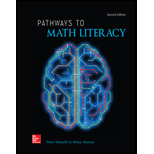
Concept explainers
Carefully read through the list of terminology we’ve used in this Unit. Consider circling the terms you aren’t familiar with and looking them up. Then test your understanding by using the list to fill in the appropriate blank in each sentence. Hint: One word is used twice.
axis
bar graph
categorical frequency distribution
classes
commutative
complement
compound interest
coordinates
data
degrees
element
empirical probability
exponential growth
grouped frequency distribution
histogram
interest
intersection
like quantities
linear growth
lower limit
origin
perimeter
pie chart
plotting points
population
probability
raw data
rectangular
representative sample
roster method
sample
scale
scientific notation
set
simple interest
stem and leaf plot
theoretical probability
time-series data
time-series graph
union
universal set
upper limit
Venn diagram
well-defined
x axis
y axis
Two quantities can only be added when they are _______________.
Want to see the full answer?
Check out a sample textbook solution
Chapter 1 Solutions
Pathways to Math Literacy
- 18.9. Let denote the boundary of the rectangle whose vertices are -2-2i, 2-21,2+i and -2+i in the positive direction. Evaluate each of the following integrals: L₁ = 2- (a). dz, (b). (d). ₁ = 22+2 [ dz, (e). √, z COS 2 dz dz, (c). L (2z+1)2dz, z(z+1)' (1). [e² si 1 sin z+ dz. (22+3)2arrow_forwardQ1: For, 0 <|z| < 1, evaluate the following integral where g is ana 9(5) inside and on the unit circle C: a) Sc - α) δε 915 αξί b) Sc d. -1/2 Llc functionarrow_forward纟 W₂ Find S-FX SB.MXarrow_forward
- Q4: Find the value of fydz, where y is given in the figure. A B 2arrow_forward4. The revenue (in thousands of dollars) from producing x units of an item is R(x)=8x-0.015 x². a) Find the average rate of change of revenue when the production is increased from 1000 to 1001 units.arrow_forwardMATH 122 WORKSHEET 3 February 5, 2025 . Solve the following problems on a separate sheet. Justify your answers to earn full credit. 1. Let f(x) = x² - 2x + 1. (a) Find the slope of the graph of y = f (x) at the point P = (0,1) by directly evaluating the limit: f'(0) = lim ( f(Ax) - f(0) Ax Ax→0 (b) Find the equation of the tangent line 1 to the graph of ƒ at P. What are the x and y intercepts of 1 ? (c) Find the equation of the line, n, through P that is perpendicular to the tangent line l. (Line n is called the normal line to the graph of f at P.) (d) Sketch a careful graph that displays: the graph of y = f (x), its vertex point, its tangent and normal lines at point P, and the x and y intercepts of these lines. Bonus: Find the coordinates of the second point, Q, (QP), at which the normal line n intersects the graph of f. 2. A rock is thrown vertically upward with an initial velocity of 20 m/s from the edge of a bridge that is 25 meters above a river bed. Based on Newton's Laws of…arrow_forward
- 1 If ye y = sin x, find dy/dx and dy/dx² at (0, 0).arrow_forward3. Use the graph for problem #35, p175 to answer the questions. The average price (in cents) per gallon of unleaded gasoline in the United States for the years 2010 to 2019 is shown in this chart. Find the average rate of change per year in the average price per gallon for each time period. Source: U.S. Energy Information Administration. a) 2010 to 2013 b) 2012 to 2018 c) 2014 to 2019arrow_forward4. Researchers at Iowa State University and the University of Arkansas have developed a piecewise function that can be used to estimate the body weight (in grams) of a male broiler during the first 56 days of life according to W(t)=48+3.64t+0.6363²+0.00963 t³ if 1St≤28, -1004+65.8t if 28arrow_forwardarrow_back_iosSEE MORE QUESTIONSarrow_forward_ios
 Holt Mcdougal Larson Pre-algebra: Student Edition...AlgebraISBN:9780547587776Author:HOLT MCDOUGALPublisher:HOLT MCDOUGAL
Holt Mcdougal Larson Pre-algebra: Student Edition...AlgebraISBN:9780547587776Author:HOLT MCDOUGALPublisher:HOLT MCDOUGAL
 Functions and Change: A Modeling Approach to Coll...AlgebraISBN:9781337111348Author:Bruce Crauder, Benny Evans, Alan NoellPublisher:Cengage Learning
Functions and Change: A Modeling Approach to Coll...AlgebraISBN:9781337111348Author:Bruce Crauder, Benny Evans, Alan NoellPublisher:Cengage Learning Glencoe Algebra 1, Student Edition, 9780079039897...AlgebraISBN:9780079039897Author:CarterPublisher:McGraw Hill
Glencoe Algebra 1, Student Edition, 9780079039897...AlgebraISBN:9780079039897Author:CarterPublisher:McGraw Hill Elementary AlgebraAlgebraISBN:9780998625713Author:Lynn Marecek, MaryAnne Anthony-SmithPublisher:OpenStax - Rice University
Elementary AlgebraAlgebraISBN:9780998625713Author:Lynn Marecek, MaryAnne Anthony-SmithPublisher:OpenStax - Rice University Intermediate AlgebraAlgebraISBN:9781285195728Author:Jerome E. Kaufmann, Karen L. SchwittersPublisher:Cengage Learning
Intermediate AlgebraAlgebraISBN:9781285195728Author:Jerome E. Kaufmann, Karen L. SchwittersPublisher:Cengage Learning





